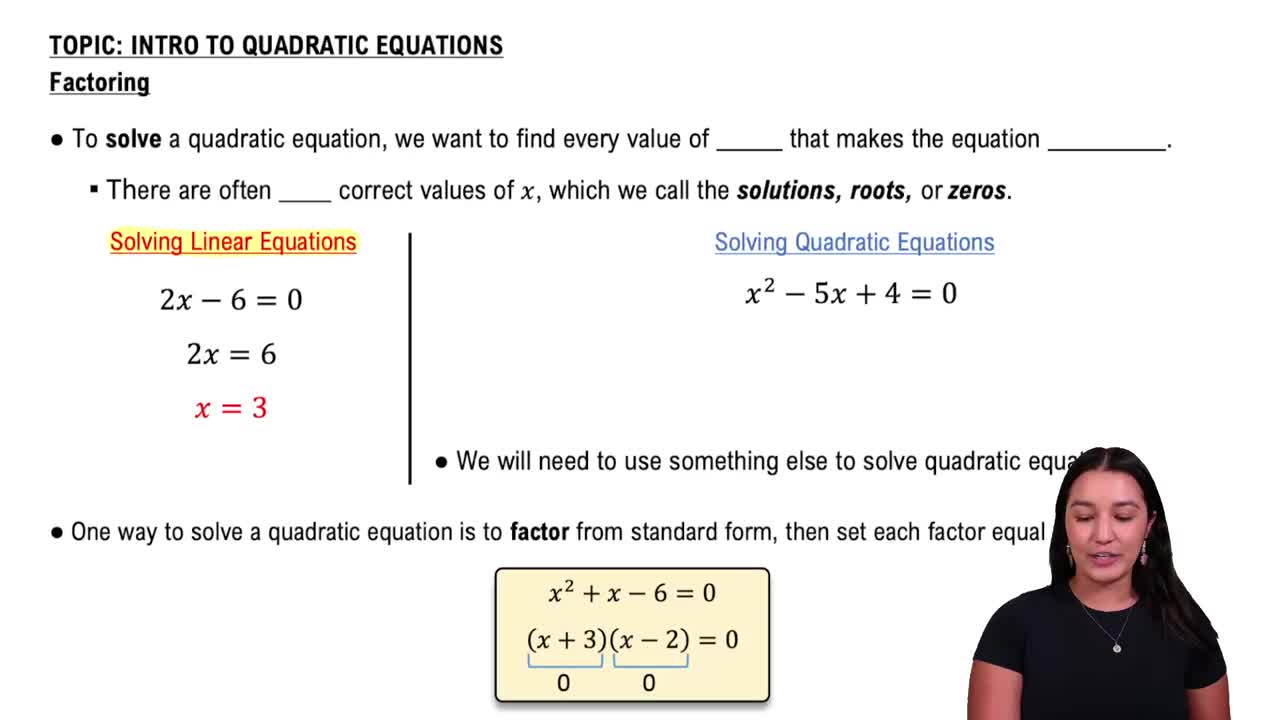Table of contents
- 0. Review of Algebra4h 16m
- 1. Equations & Inequalities3h 18m
- 2. Graphs of Equations43m
- 3. Functions2h 17m
- 4. Polynomial Functions1h 44m
- 5. Rational Functions1h 23m
- 6. Exponential & Logarithmic Functions2h 28m
- 7. Systems of Equations & Matrices4h 6m
- 8. Conic Sections2h 23m
- 9. Sequences, Series, & Induction1h 19m
- 10. Combinatorics & Probability1h 45m
1. Equations & Inequalities
Intro to Quadratic Equations
Problem 72
Textbook Question
In Exercises 71–72, without solving the given quadratic equation, determine the number and type of solutions. 9x^2 = 2-3x
 Verified step by step guidance
Verified step by step guidance1
Convert the equation into standard quadratic form ax^2 + bx + c = 0 by moving all terms to one side of the equation. For the equation 9x^2 = 2 - 3x, add 3x and subtract 2 from both sides to get 9x^2 + 3x - 2 = 0.
Identify the coefficients from the standard form of the quadratic equation, where a = 9, b = 3, and c = -2.
Calculate the discriminant using the formula \(\Delta = b^2 - 4ac\). Substitute the identified coefficients into the formula to find the value of the discriminant.
Analyze the value of the discriminant to determine the nature of the solutions: If \(\Delta > 0\), the equation has two distinct real solutions; if \(\Delta = 0\), the equation has exactly one real solution (a repeated root); if \(\Delta < 0\), the equation has two complex conjugate solutions.
Based on the calculated discriminant, conclude the number and type of solutions for the quadratic equation without solving it.
Recommended similar problem, with video answer:
 Verified Solution
Verified SolutionThis video solution was recommended by our tutors as helpful for the problem above
Video duration:
3mPlay a video:
Was this helpful?
Key Concepts
Here are the essential concepts you must grasp in order to answer the question correctly.
Quadratic Equations
A quadratic equation is a polynomial equation of the form ax^2 + bx + c = 0, where a, b, and c are constants and a ≠ 0. The solutions to these equations can be found using various methods, including factoring, completing the square, or applying the quadratic formula. Understanding the structure of quadratic equations is essential for analyzing their solutions.
Recommended video:

Introduction to Quadratic Equations
Discriminant
The discriminant of a quadratic equation, given by the formula D = b^2 - 4ac, is a key component in determining the nature of the solutions. It indicates whether the solutions are real or complex, and whether they are distinct or repeated. Specifically, if D > 0, there are two distinct real solutions; if D = 0, there is one real solution; and if D < 0, there are two complex solutions.
Recommended video:

The Discriminant
Standard Form
The standard form of a quadratic equation is crucial for analysis and is typically expressed as ax^2 + bx + c = 0. To analyze the given equation, it may need to be rearranged into this form. This allows for the identification of coefficients a, b, and c, which are necessary for calculating the discriminant and determining the number and type of solutions.
Recommended video:
Guided course

Standard Form of Polynomials

 5:35m
5:35mWatch next
Master Introduction to Quadratic Equations with a bite sized video explanation from Callie
Start learningRelated Videos
Related Practice










